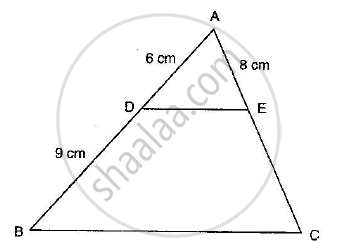Advertisements
Advertisements
Question
State Pythagoras theorem and its converse.
Solution
TO STATE: Pythagoras theorem and its converse.
PYTHAGORAS THEOREM: In a right angled triangle, the square of the hypotenuse is equal to the sum of the squares of the other two sides.
`\text{hypotenuse}^2=\text{perpendicular}^2+\text{base}^2`
CONVERSE OF PYTHAGORAS THEOREM: In a triangle, if the square of one side is equal to the sum of the square of the other two sides then the angle opposite to the greatest side is a right angle.
APPEARS IN
RELATED QUESTIONS
The incircle of an isosceles triangle ABC, in which AB = AC, touches the sides BC, CA and AB at D, E and F respectively. Prove that BD = DC.
Diagonals AC and BD of a trapezium ABCD with AB || DC intersect each other at the point O. Using similarity criterion for two triangles, show that `"OA"/"OC"="OB"/"OD"`.
A vertical stick of length 6 m casts a shadow 4 m long on the ground and at the same time a tower casts a shadow 28 m long. Find the height of the tower.
ABCD is a trapezium having AB || DC. Prove that O, the point of intersection of diagonals, divides the two diagonals in the same ratio. Also prove that
In ∆ABC, AD and BE are altitude. Prove that\[\frac{ar\left( ∆ DEC \right)}{ar\left( ∆ ABC \right)} = \frac{{DC}^2}{{AC}^2}\]
In the adjoining figure, find AC.

The lengths of the diagonals of a rhombus are 30 cm and 40 cm. Find the side of the rhombus.
If ∆ABC and ∆DEF are two triangles such tha\[\frac{AB}{DE} = \frac{BC}{EF} = \frac{CA}{FD} = \frac{2}{5}\] , then Area (∆ABC) : Area (∆DEF) =
∆ABC ∼ ∆DEF, ar(∆ABC) = 9 cm2, ar(∆DEF) = 16 cm2. If BC = 2.1 cm, then the measure of EF is
∆ABC is a right triangle right-angled at A and AD ⊥ BC. Then, \[\frac{BD}{DC} =\]
